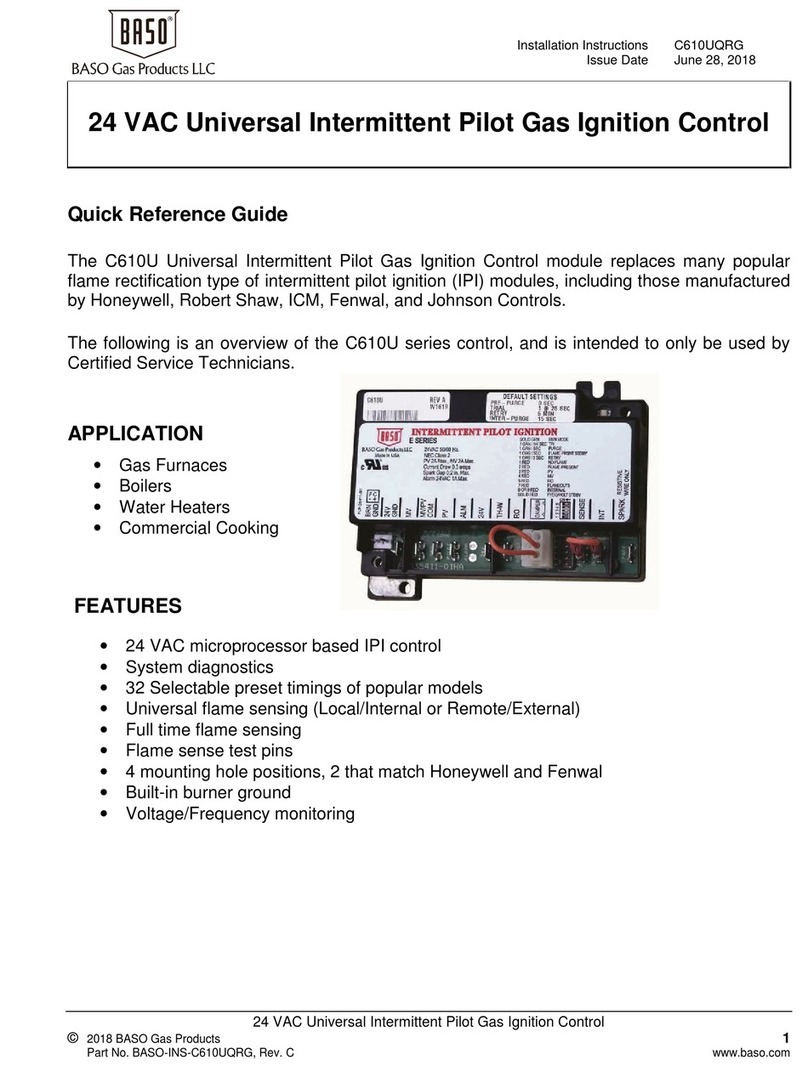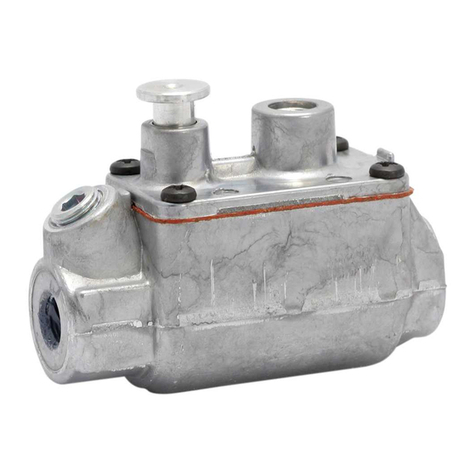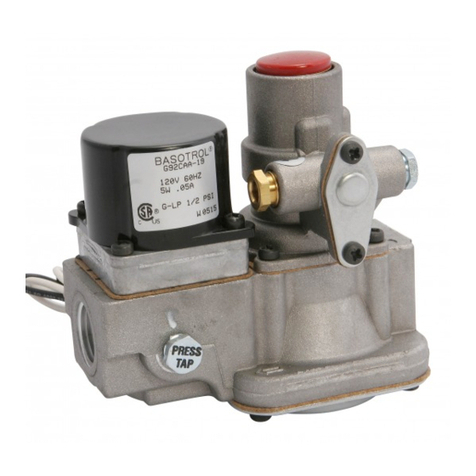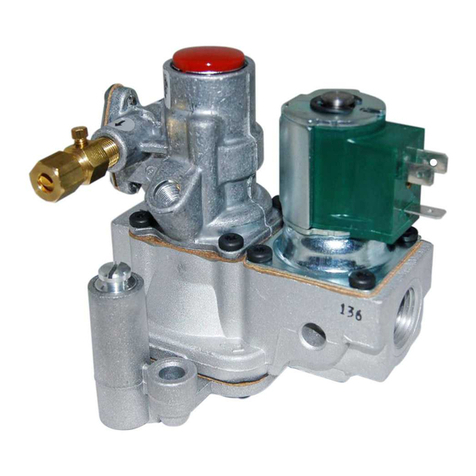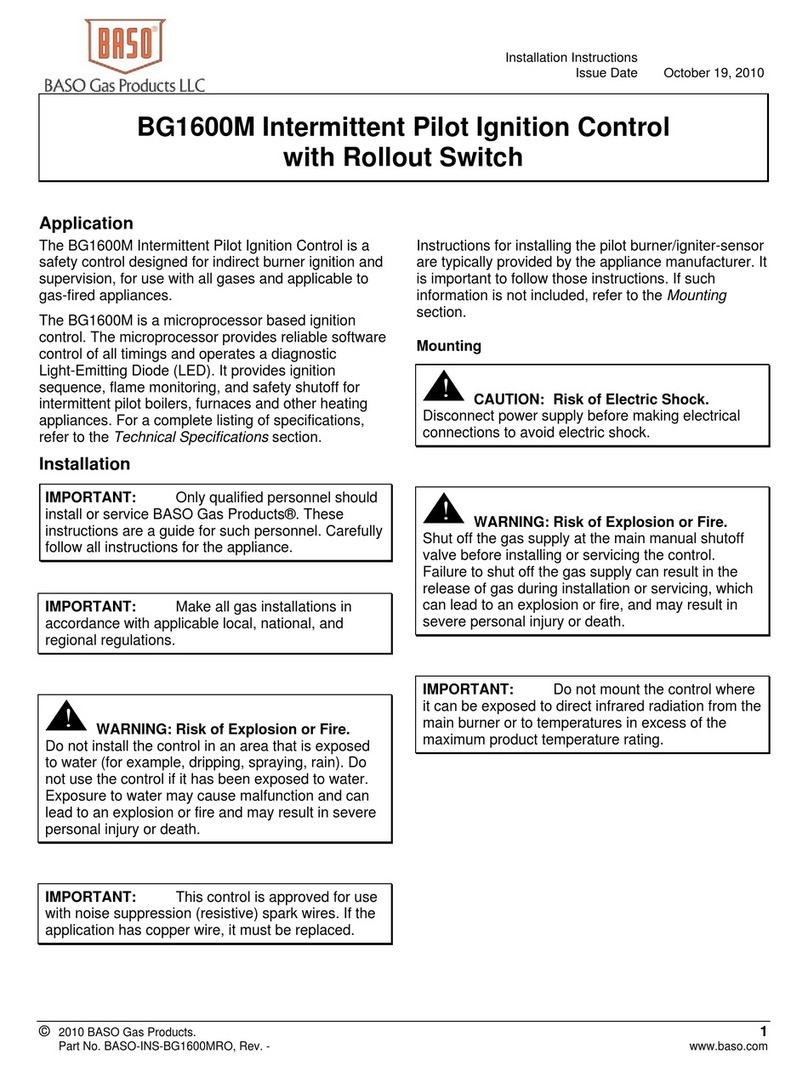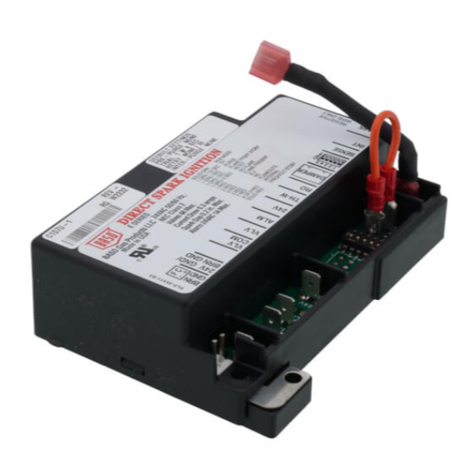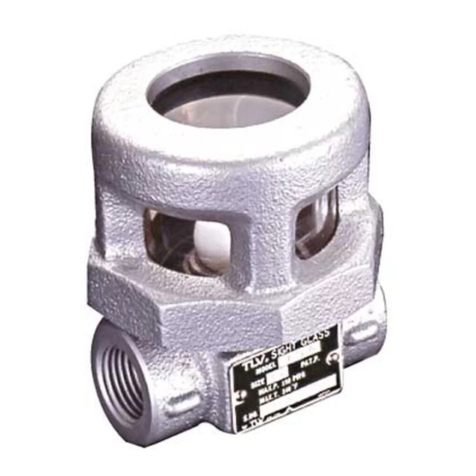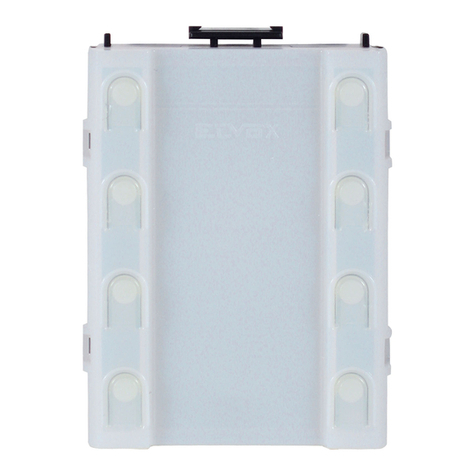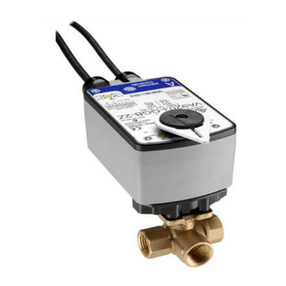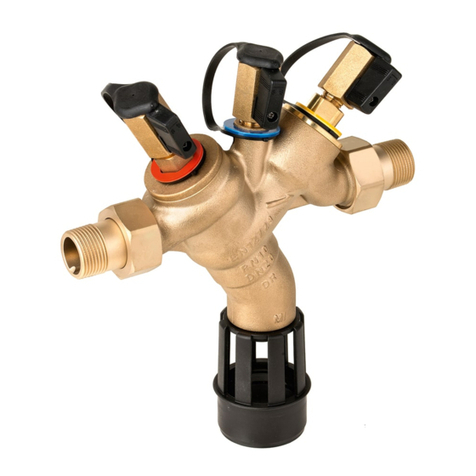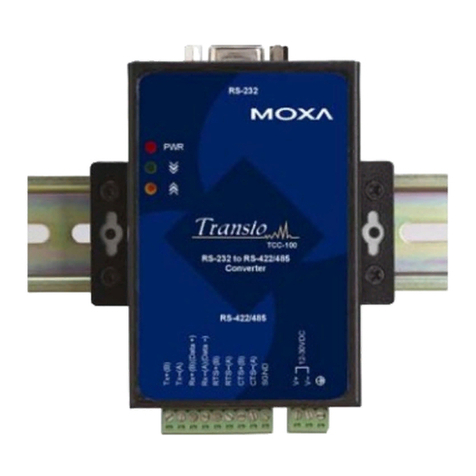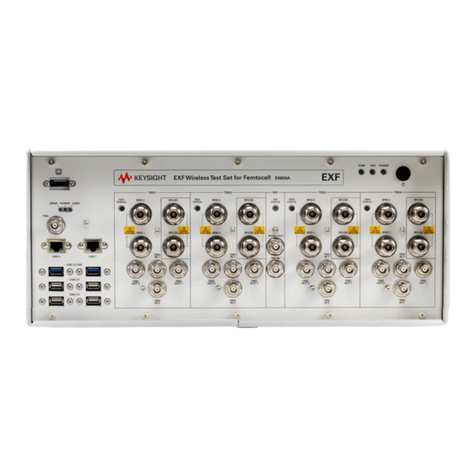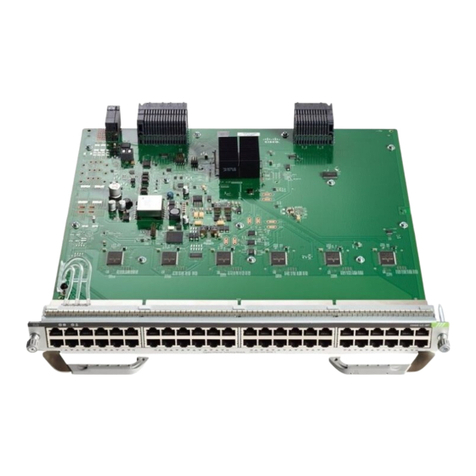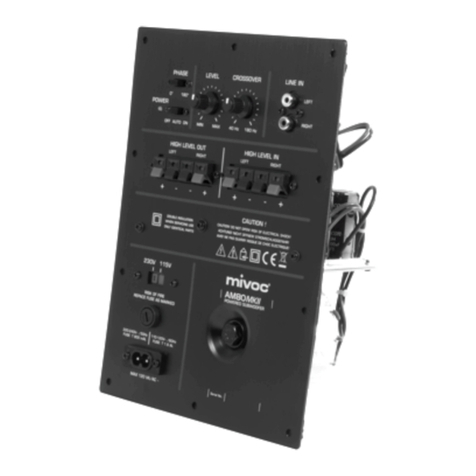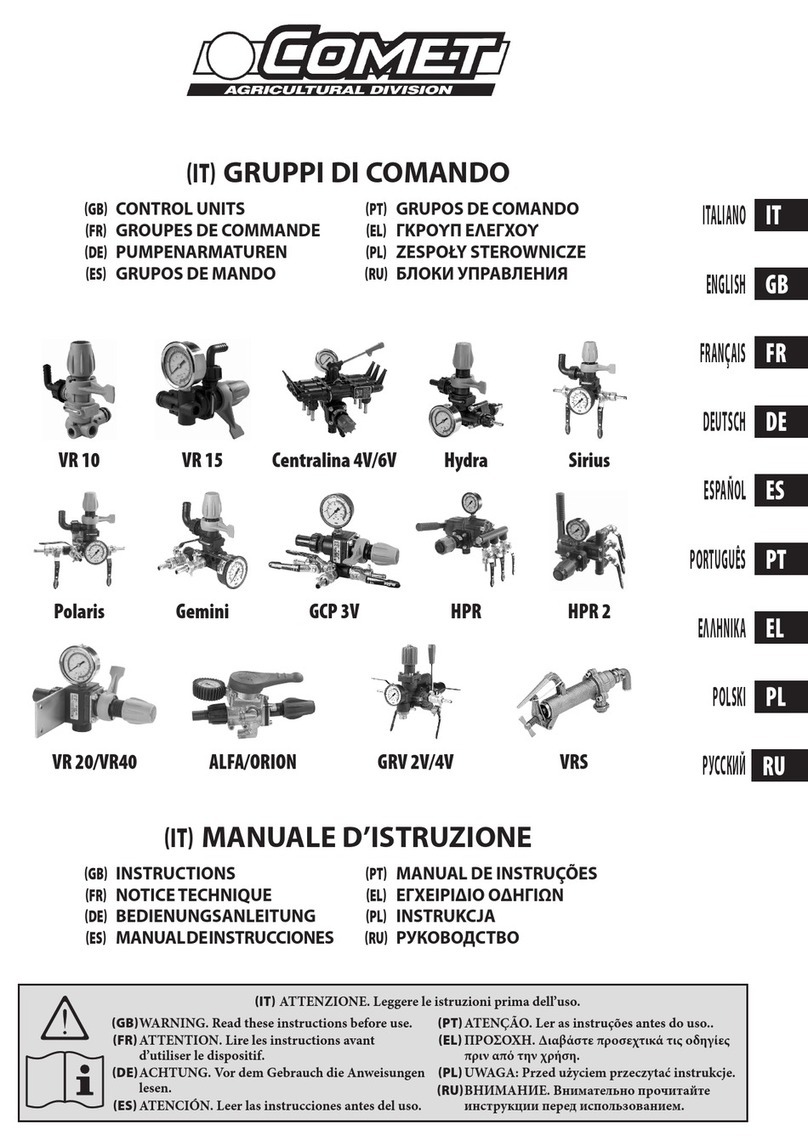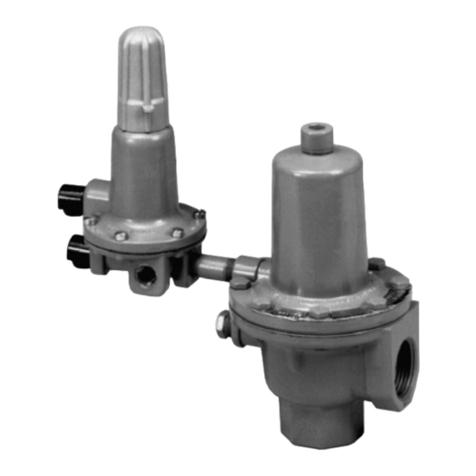Baso BG1600M User manual

Installation Instructions
Issue Date May 11, 2009
© 2009 BASO Gas Products. 1
Part No. BASO-INS-BG1600M, Rev. A www.baso.com
BG1600M Intermittent Pilot Ignition Control
Application
The BG1600M Intermittent Pilot Ignition Control is a
safety control designed for indirect burner ignition and
supervision, for use with all gases and applicable to
gas-fired appliances.
The BG1600M is a microprocessor based ignition
control. The microprocessor provides reliable software
control of all timings and operates a diagnostic
Light-Emitting Diode (LED). It provides ignition
sequence, flame monitoring, and safety shutoff for
intermittent pilot boilers, furnaces and other heating
appliances. For a complete listing of specifications,
refer to the Technical Specifications section.
Installation
IMPORTANT: Only qualified personnel should
install or service BASO Gas Products®. These
instructions are a guide for such personnel. Carefully
follow all instructions for the appliance.
IMPORTANT: Make all gas installations in
accordance with applicable local, national, and
regional regulations.
!
WARNING: Risk of Explosion or Fire.
Do not install the control in an area that is exposed
to water (for example, dripping, spraying, rain). Do
not use the control if it has been exposed to water.
Exposure to water may cause malfunction and can
lead to an explosion or fire and may result in severe
personal injury or death.
IMPORTANT: This control is approved for use
with noise suppression (resistive) spark wires. If the
application has copper wire, it must be replaced.
Instructions for installing the pilot burner/igniter-sensor
are typically provided by the appliance manufacturer. It
is important to follow those instructions. If such
information is not included, refer to the Mounting
section.
Mounting
!
CAUTION: Risk of Electric Shock.
Disconnect power supply before making electrical
connections to avoid electric shock.
!
WARNING: Risk of Explosion or Fire.
Shut off the gas supply at the main manual shutoff
valve before installing or servicing the control.
Failure to shut off the gas supply can result in the
release of gas during installation or servicing, which
can lead to an explosion or fire, and may result in
severe personal injury or death.
IMPORTANT: Do not mount the control where
it can be exposed to direct infrared radiation from the
main burner or to temperatures in excess of the
maximum product temperature rating.

2BG1600M Intermittent Pilot Ignition Control Installation Instructions
Location Considerations
Choose a location that provides the shortest, direct
cable route to the spark electrode, pilot burner/igniter-
sensor assembly. Easy access to the terminals is
desired for wiring and servicing. The control may be
mounted in any position. Mount the control on a
grounded metal surface with #6 sheet metal or
machine screws through the mounting holes provided
in the enclosure.
The pilot burner/igniter-sensor must be securely
mounted to the main burner to ensure that the pilot
burner flame remains properly positioned with respect
to the main burner flame. The pilot burner must be
located such that the flame receives an ample supply
of air, free from the products of combustion. The flame
must not be exposed to draft conditions, the full force
of main burner ignition, or falling scale, which could
otherwise impede ignition of main burner flame.
Securely mount the pilot burner/igniter-sensor to the
main burner with metal screws at a distance
approximately 3/8 in (9.52 mm) above and 1/4 in. (6.35
mm) away from the center of the nearest main burner
port. Ensure that the main burner flames do not
impinge on any part of the pilot burner.
Wiring
!
WARNING: Risk of Explosion or Fire.
Locate all safety, limit, and operating controls in
series with the thermostat terminal (TH) on the
ignition control. Improper installation may cause gas
leaks, which can lead to an explosion or fire and
may result in severe personal injury or death.
Refer to Figure 1 through Figure 4 for wiring diagrams.
All wiring should be in accordance with the National
Electrical Code (NEC) and all other local codes and
regulations.
Check the voltage rating marked on the control and
make sure it is suited to the application. Use a Class 2
transformer capable of providing 24 VAC under
maximum load, including valves. A transformer having
excessive primary impedance due to poor coupling
affects the ignition potential.
The high-voltage spark transformer cable is noise
suppression (resistive) type rated for at least 15Kv and
must not be in continuous contact with a metal
surface. Use standoff insulators. Ensure that the flame
sensor wire and high voltage spark transformer cable
are separated from one another by a minimum of
1/4 in. (6.35 mm) and are not wrapped around any
pipe, other wiring, or accessories.
The control is supplied with a jumper wire between
Sense and Internal terminals and is ready for internal
(one rod) flame sense. With the jumper in, flame is
sensed through the high voltage spark wire. The
jumper must be removed for external (two rod) flame
sense and the sense electrode wired to the Sense
terminal.
Note: A shorting plug that jumpers pins 2 and 3 of the
damper connector is supplied with the control. The
shorting plug must be used if a vent damper is not
used. When a vent damper has been connected and
power turned on, an internal fuse in the control will
blow and the control will only operate with a vent
damper connected. Now you cannot disconnect the
vent damper plug and put back the shorting plug. The
ignition control will not work.
!
WARNING: Risk of Electric Shock.
Before applying power to the control, connect the
high voltage cable to the spark transformer terminal
and spark electrode (pilot burner assembly). Verify
the ground wire is attached to the pilot burner and
the control ground terminal strip. Failure to follow
this procedure can cause electric shock and may
result in severe personal injury or death.
The BG1600M replaces existing intermittent pilot
ignition controls with the following specifications:
•flame detection using flame rectification
technology (ability of a flame to conduct and
rectify current)
•Single rod (local sense) or dual rod (remote
sense) flame sensing
•100% shutoff/lockout with none, 5 or 60
minutes continuous retry
•trial times of infinite, 5, 10, 15, 20, 25, 30, 60
or 90 seconds
•prepurge period of 0, 10, 15, 30 or 45
seconds
•main burner 400,000 Btu/hr maximum
•pilot burners with flow rates of 1,500 Btu/hr or
less
•with or without automatic vent damper
•must be used with redundant gas valves and
not subjected to temperatures below
-40˚F (-40˚C) or above 170˚F (77˚C)

BG1600M Intermittent Pilot Ignition Control Installation Instructions 3
MV MV/PV PV
GND
BURNER
GND 24V TH SENSE
INTERNAL
SPARK
Pilot
Ground
Thermostat
High
Temp
Limit
Pilot
Burner/ignitor
Combination
Gas Valve
Jumper
24VAC
Class 2
Transformer
12345678 10
9
L1 (Hot)
L2 (Neu)
1
2
3
4
5
1
2
3
5
4
Power Supply. Provides disconnect means and overload protection as required.
Maximum cable length 48 inches (1,220 mm). (Resistive wire recommended.)
For single rod application, leave jumper wire in if supplied.
Alternate location for limit controller.
Controls in 24V circuit must not be in ground leg to transformer.
Earth
GND
Figure 1: Wiring for 1 Rod Flame Sense without Vent Damper
1
2
3
5
4
Power Supply. Provides disconnect means and overload protection as required.
Maximum cable length 48 inches (1,220 mm). (Resistive wire recommended.)
For two rod application, if jumper wire is supplied, remove jumper wire before installation.
Alternate location for limit controller.
Controls in 24V circuit must not be in ground leg to transformer.
MV MV/PV PV
GND
BURNER
GND 24V SENSE SPARK
Pilot
Ground
Thermostat
High
Temp
Limit
Pilot
Burner/Ignitor Flame
Sensor
Combination
Gas Valve
24VAC
Class 2
Transformer
INTERNAL
Discard Sense
Jumper
TH
12345678910
1
2
4
5
L1 (Hot)
L2 (Neu)
3
Earth
GND
2
Figure 2: Wiring for 2 Rod Flame Sense without Vent Damper

4BG1600M Intermittent Pilot Ignition Control Installation Instructions
MV MV/PV PV
GND
BURNER
GND 24V TH SENSE
INTERNAL
SPARK
Pilot
Ground
Thermostat
High
Temp
Limit
DAMPER
PLUG
Vent
Damper
Wiring
Harness
Pilot
Burner/Ignitor
Combination
Gas Valve
Jumper
24VAC
Class 2
Transformer
1
2
3
5
4
Power Supply. Provides disconnect means and overload protection as required.
Maximum cable length 48 inches (1,220 mm). (Resistivewire recommended.)
For single rod application, leave jumper wire in if supplied.
Alternate location for limit controller.
Controls in 24V circuit must not be in ground leg to transformer.
12345678 910
L1 (Hot)
L2 (Neu)
1
2
3
4
5
Earth
GND
Note:
If a damper is not used,
use the pin 2-3 jumper plug
supplied with the control and
omit 24V connection.
Figure 3: Wiring for 1 Rod Flame Sense with Vent Damper
MV MV/PV PV
GND
BURNER
GND 24V TH SENSE SPARK
Pilot
Ground
Thermostat
DAMPER
PLUG
Vent
Damper
Wiring
Harness
Pilot
Burner/Ignitor Flame
Sensor
Combination
Gas Valve
24VAC
Class 2
Transformer
INTERNAL
Discard jumper
plug supplied
with the control.
Discard Sense
Jumper
High
Temp
Limit
1
2
3
5
4
Power Supply. Provides disconnect means and overload protection as required.
Maximum cable length 48 inches (1,220 mm). (Resistive wire recommended.)
For two rod applications, if jumper wire is supplied, remove jumper wire before installation.
Alternate location for limit controller.
Controls in 24V circuit must not be in ground leg to transformer.
123456789
10
L1 (Hot)
L2 (Neu)
1
2
3
4
5
2
Earth
GND
Note:
If a damper is not used,
use pin 2-3 jumper plug
supplied with the control
and omit 24V connection.
Figure 4: Wiring for 2 Rod Flame Sense with Vent Damper

BG1600M Intermittent Pilot Ignition Control Installation Instructions 5
Setup and Adjustments
Checkout
!
WARNING: Risk of Explosion or Fire.
Verify that there are no gas leaks by testing with
appropriate equipment. Never use a match or lighter
to test for the presence of gas. Failure to test
properly can lead to an explosion or fire and may
result in severe personal injury or death.
Make sure all components function properly by
performing the following test.
1. Before starting the appliance, perform a safety
inspection of piping, burners and venting. Check
for water leaks, etc. Check all wiring for proper
connections. Be sure the system is properly
grounded, including ground connection to the
pilot burner.
2. With the gas and thermostat off, turn on power to
the appliance.
3. Turn the thermostat to a high setting and verify
that the control goes through the operating
sequence to a shutoff condition.
Note: The burner does not light because the
gas is off.
4. Turn off the thermostat.
5. Turn on the gas and purge gas lines of all air.
6. Check for gas leaks on all pipe joints upstream of
the gas valve with a soap solution.
7. Turn the thermostat to the highest setting and
verify successful ignition and a normal run
condition for at least 5 minutes. If the appliance
fails to run, see the Troubleshooting section.
8. Check for gas leaks on all pipe joints downstream
of the gas valve with a soap solution.
9. Turn the thermostat down for at least 30 seconds
and then back up again. Verify successful ignition
at least five times.
10. Return the thermostat to a normal temperature
setting before leaving the installation.
!
WARNING:
The control module can not be serviced by user. If
any faults are detected, the control module must be
replaced. If control module has been opened or any
attempts to repair are done, the warranty is void.
Operation
Operating Mode Definitions
The following definitions describe the BG1600M
operating conditions.
•Prepurge: Initial time delay between thermostat
contact closure and activation of the spark circuit
and pilot valve.
•Trial for Ignition: Total time the pilot valve is
energized and spark/sense sequence is activated
in an attempt to light the pilot. The control attempts
to prove flame within the trial-for-ignition time.
•100% Shutoff: If the control does not prove the
presence of pilot burner flame within the trial for
ignition, the spark circuit and pilot valve are
de-energized.
•Recycle: If 100% shutoff occurs, the control
delays for a specific recycle delay period before
beginning another trial for ignition (models with
recycle only).
•Run: Main valve is energized and spark turns off
after pilot flame is proven. The main valve remains
energized until the thermostat is satisfied.
•Flameout: Loss of proven flame. Should a
flameout occur, the main valve de-energizes and
spark recurs within 2.0 seconds.
•Lockout: An internal or external fault has caused
the control to de-energize the spark circuit and
valve relays. The thermostat contacts must be
opened for 30 seconds and then closed to begin
another trial for ignition.
•Inter-Purge: Period between trials for ignition
when both the gas valve and spark are
de-activated to allow unburned gas to escape
before the next trial.
Sequence of Operation
The heating cycle start when a call for heat from the
thermostat supplies 24VAC to the TH terminal. The
automatic vent damper (if used) is energized and
when fully open, turns on the power to the ignition
control. After a 1 second maximum diagnostic period,
the spark will start and the pilot valve will turn on,
starting with the trial for ignition period.
During the trial for ignition period, the control sparks
for 4 seconds while rapidly flashing LED. It then turns
off the spark and LED for 1 second while checking
pilot flame sense. This cycle will repeat until pilot flame
is detected or trial time is over.
When pilot flame is detected, the spark will stop, main
valve will turn on and the LED will stay on
continuously. The control will remain in this state until

6BG1600M Intermittent Pilot Ignition Control Installation Instructions
the pilot flame is lost or the call for heat ends. If pilot
flame is lost, LED, main and pilot valves are turned off
for 0.5 seconds and a new trial for ignition sequence
will start.
If pilot flame is not detected during the trial for ignition
period, the pilot valve will be shut off. Lockout will
occur if your model has no retry. Otherwise, after
5 minutes or 60 minutes (for recycle units only) the
control will delay for the specific recycle delay period
before beginning another trial for ignition.
Table 1: LED Indications During Normal Operation
Flash Code Flash Code Indication
Steady On Flame detected, main burner on
.1 Second On
.1 Second Off Trial time spark on trying to light
pilot burner
.25 Second On
1.0 Second Off Trial time lockout
Troubleshooting
If the system does not function properly, determine the
cause using the procedures in this section.
Before proceeding with troubleshooting the system,
check the following.
Preliminary Checks
Are you using resistive wire between the module
spark (10) and the pilot connection?
Are all mechanical and electrical connections
tight?
Is the system wired and ground correctly?
Is gas inlet pressure per manufacturer’s
specifications?
Is the system powered?
Is the thermostat calling for heat?
LED Error Indications
If the control module internal diagnostics detect a fault
it will go to lockout. Spark and both valves will be
turned off. The LED will flash the error code .25
seconds on and .25 seconds off for each count of the
error code with 1 second off between codes. The
control will remain in this condition until power is
removed by turning off the call for heat. Codes indicate
a problem with the control and it must be replaced.
Table 2: LED Error Indications
Flash Code Flash Code Description
1 No flame in trial time
2 Flame sense circuit error
3 Pilot valve circuit error
4 Main valve circuit error
5 to 9 Internal control error
!
WARNING: Risk of Personal Injury.
Do not place face, hands, or other parts of the body
in or near the burner area when the LED is flashing
(recycle mode). When the LED is flashing, the
control may at any time (while in the recycle mode)
re-energize the burner control system and ignite the
burner which may result in electric shock from
contact with the electrode or severe burn injury from
firing of the burner.

BG1600M Intermittent Pilot Ignition Control Installation Instructions 7
No
Yes
Idle State
Call for heat
from the thermostat
If damper connected
wait for it to open
POWER TO CONTROL
One second for
diagnostic routines
If pre-purge wait
flashing LED once a
second until over
Turn on spark and
pilot gas valve
start trial timer
Spark on 4 seconds
blinking LED rapidly
spark off 1 second
Flame
on?
Flame
on?
Wait 0.5 second
Trial
over?
No
Turn on main
gas valve and LED
Yes
No
Turn pilot gas
valve off
Yes
Retry
option?
Wait 5 or 60 minutes,
blink LED every 15 seconds
TRIAL
TIME
LOOP
TRIAL
TIME
OVER
RESTART
Note:
If the thermostat opens,
the control will turn off valves
and returns to the idle state.
Wait 0.1 second
checking memory and
relay driver circuits
OK
Flame
on? Yes
No
Flame off
0.7 second?
Turn pilot and main
gas valves off
wait 0.5 second
Yes
No
FLAME LOST, TURN
OFF VALVES AND
TRY TO RE-LIGHT
FLAME ON MONITOR LOOP
RE-LIGHT
Note:
Error Codes
Lock out on timeout or fault detected,
turn off relays and spark loop blinking
error code until power off.
No flame in trial time.
Flame sense stuck on.
Pilot relay driver fault.
Main relay driver fault.
Processor errors.
1 Blink
2 Blinks
3 Blinks
4 Blinks
5 to 9 Blinks
Yes
Lockout
Figure 5: Sequence of Operation

8BG1600M Intermittent Pilot Ignition Control Installation Instructions
Yes
No
No
Yes
Turn on power
and gas.
Close thermostat
contacts.
Module LED
did not light and
no spark?
Module LED
blinks slowly? Diagnostic error
see next page.
Replace module.
24V between
TH and GND
terminals?
Yes
No
Yes
Module LED
blinks rapidly but
no spark?
Damper
used?
No
Shorting
plug in?
Check transformer,
thermostat and wiring.
Repair or replace as needed.
24V between
damper pin 2 & 4?
Yes
Replace
module.
Check and repair
damper, and/or
damper wiring.
No
Yes
Yes
No
Connect pin 2-3
shorting plug to
damper.
No
Spark wire
and electrode
OK? Replace
module.
Replace spark wire
or electrode.
Yes Yes
No
Pilot flame
does not
light?
24V between
PV and GND
terminals?
Replace
module.
Gas at pilot
burner?
Yes
Yes
No Check shutoff valves are on.
Check wiring to pilot valve.
Check orfice and tubing are clear.
If all OK replace pilot valve.
Adjust or replace spark
electrode and/or pilot
burner.
No
Pilot lights
but keeps
sparking?
Pilot flame in contact
with spark or sense
electrode?
NoYes
Yes
Replace
module.
No
Check burner orifice.
Adjust pilot flame size or
electrode position.
Two rod
flame sense?
Yes
Check wiring electrode
to SENSE terminal.
If OK replace module.
Pilot is lit
continued
on next page
No
No
Figure 6: Troubleshooting Flow Chart (1 of 2)

BG1600M Intermittent Pilot Ignition Control Installation Instructions 9
No
Yes
Continued
from previous page
Pilot is lit
Main burner
failed to turn
on?
24V between
MV and MV/PV
terminals?
Yes
No
Yes
No
Check that shutoff valves are on.
Check wiring to main valve.
Check tubing is clear.
If all OK replace main valve.
Yes
No
Replace
module.
Yes
Yes
No
Gas at main
burner?
Adjust pilot flame size
and position, or replace
pilot burner or main burner.
After main is
lit, do valves turn off
and start new
cycle?
Pilot flame in
contact with spark or
sense electrode? Adjust pilot flame size or
electrode position.
Replace
module.
No
Two rod
flame sense?
Yes
Check wiring electrode
to SENSE terminal.
If OK replace module.
Control is
operating
normally.
Figure 7: Troubleshooting Flow Chart (2 of 2)

10 BG1600M Intermittent Pilot Ignition Control Installation Instructions
Maintenance Requirements in Severe
Environments
Regular preventive maintenance is important in any
application, but especially so in commercial cooking,
agricultural, and industrial applications because:
•In many such applications, particularly
commercial cooking, the equipment operates
100,000 to 200,000 cycles per year. Such heavy
cycling can wear out the gas control in one to
two years. A normal forced air furnace, for which
the controls were originally intended, typically
operates less than 20,000 cycles per year.
•Exposure to water, dirt, chemicals, and heat can
damage the ignition control module or the gas
control and shut down the control system. A
NEMA 4 enclosure can reduce exposure to
environmental contaminants.
!
WARNING: Risk of Explosion or Fire. Do
not attempt to take the ignition control module apart
or to clean it. Improper reassembly and cleaning
may cause unreliable operation, which can lead to
an explosion or fire, and may result in severe injury,
property damage or death.
Maintenance frequency must be determined
individually for each application. Some considerations
are:
•Cycling Frequency – Appliances that may cycle
more than 20,000 times annually should be
checked monthly.
•Intermittent Use – Appliances that are used
seasonally should be checked before shutdown
and again before the next use.
•Consequence of Unexpected Shutdown –
Where the cost of an unexpected shutdown
would be high, the system should be checked
more often.
•Dust, Wet, or Corrosive Environment – Since
these environments can cause the controls to
deteriorate more rapidly, the system should be
checked more often.
Repairs and Replacement
!
CAUTION: Risk of Electric Shock.
Disconnect power supply before making electrical
connections to avoid electric shock.
!
WARNING: Risk of Explosion or Fire.
Shut off the gas supply at the main manual shutoff
valve before installing or servicing the control.
Failure to shut off the gas supply can result in the
release of gas during installation or servicing, which
can lead to an explosion or fire, and may result in
severe injury or death.
!
WARNING: Risk of Explosion, Fire, or
Electric Shock. Label all wires before they are
disconnected when replacing or servicing the
BG1600M. Wiring errors can cause improper or
dangerous operation and may result in an explosion,
fire, or electric shock leading to severe personal
injury or death.
Field repairs must not be made to the BG1600M
control. Any attempt to repair this assembly voids the
manufacturer’s warranty. For a replacement control,
contact the original equipment manufacturer or the
nearest BASO Gas Products distributor.
All other accessories, such as flame sensors,
electrode assembles, pilot assemblies, and leads can
be obtained through the original equipment
manufacturer or a BASO Gas Products distributor.

BG1600M Intermittent Pilot Ignition Control Installation Instructions 11
Technical Specification
Product BG1600M Intermittent Pilot Ignition Control
Ignition Type Indirect
Ignition Source High voltage spark, capacitive discharge
High Voltage Cable
Maximum Length 48 in. (1,220 mm) (Resistive wire recommended, rated for at least 15kV.)
Flame Sense Cable
Maximum Length 48 in. (1,220 mm)
Flame Detection Means Flame Rectification
Flame Detection Type Local or Remote
Minimum Flame Current 0.15 microamperes
Flame Failure Response
Time 2 seconds maximum
Maximum Spark Gap 0.2 in. (5.1 mm)
Number of Trials Before
100% Shutoff One
Trial-for-Ignition Time Infinite, 5, 10, 15, 20, 25, 30, 60, or 90 seconds
Prepurge Time 0, 10, 15, 30, or 45 seconds
Automatic Recycle Delay
Period None
5 minutes
60 minutes
Power Requirements Control:
Operation Current: 24 VAC (+/- 20%), 50/60 Hz
0.2 A nominal + valves
Contact Rating Main Valve:
Pilot Valve: 2 A maximum
1 A maximum
Wiring Connections 1/4 in. (6.35 mm) male spade
Maximum Firing Rate 400,000 Btu/hr (117 kW)
Ambient Operating and
Storage Temperature -40 to 170°F (-40 to 77°C)
Humidity 95% RH noncondensing
Type of Gas Natural, Liquefied Petroleum (LP), Manufactured, Mixed or LP Gas-Air Mixture
Packaging Bulk pack supplied to original equipment manufacturer (25 per box)
Individual pack (1 per box)
Individual overpack (20 per box)
Pack Weight Bulk pack 14 lb (6.36 kg)
Individual pack 1 lb (.454 kg)
Individual overpack 18 lb (8.17 kg)
Agency Listing CSA Certificate Number 246569-2161442
Specifications Standards ANSI Standard Z21.20
CAN/CSA-C22.2 No. 199
The performance specifications are nominal and conform to acceptable industry standards. All agency certification of BASO products is
performed under dry and controlled indoor environmental conditions. Use of BASO products beyond these conditions is not recommended and
may void the warranty. If the product is exposed to water (dripping, spraying, rain, etc.) or other harsh environments, it must be protected. The
original equipment manufacturer or end user is responsible for the correct application of BASO products. For questionable applications, please
consult BASO Gas Products LLC. BASO Gas Products LLC shall not be liable for damages or product malfunctions resulting from
misapplication or misuse of its products.
1007 South 12th Street
PO Box 170
Watertown, WI 53094 Published in U.S.A.
1-877-227-6427 www.baso.com
Other manuals for BG1600M
1
Table of contents
Other Baso Control Unit manuals
Popular Control Unit manuals by other brands

EVC electronic
EVC electronic OLS300 manual

Kettler
Kettler neo EBCIM17 Assembly, operation & maintenance instructions
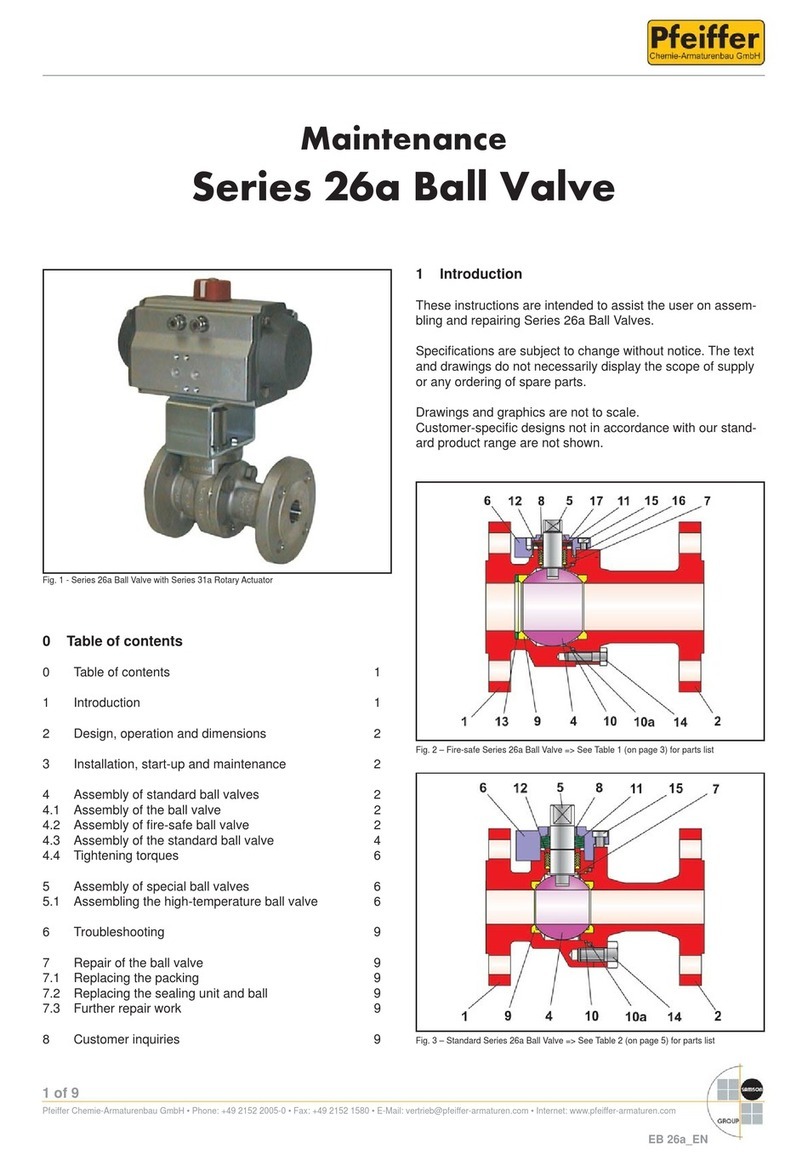
Pfeiffer
Pfeiffer 26a Series maintenance

W.E.S.T. Elektronik
W.E.S.T. Elektronik POS-124-A-PDP Technical documentation
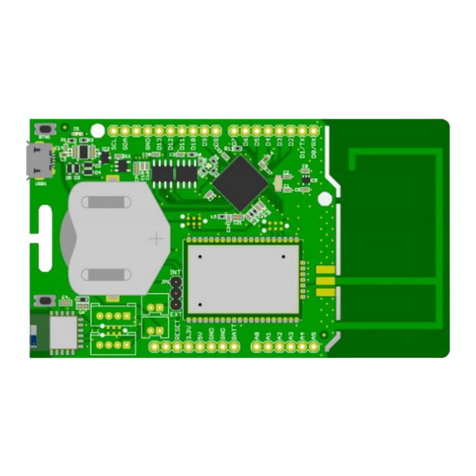
Microchip Technology
Microchip Technology ExpLoRer user guide

Pickering
Pickering 40-297A user manual
